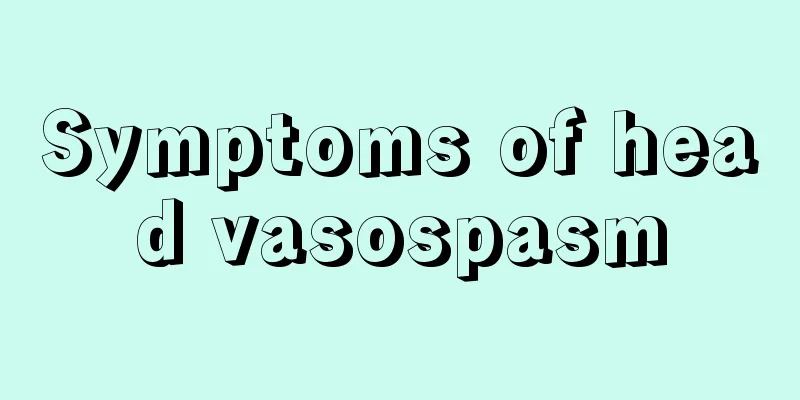Symptoms of head vasospasm

|
In life, many people often feel head vasospasm. Head vasospasm includes many problems. The most common one is that it will cause many obvious headaches, cerebral vasospasm, and even dizziness, as well as many other symptoms. These are all worthy of attention. In addition, it may cause severe pain and tenderness, which are also more harmful. Symptoms and signs Dizziness and headache are prominent characteristics. If dizziness occurs frequently, you should be alert to the occurrence of cerebral vasospasm. Headache is an early symptom of cerebral vasospasm, especially persistent headache, which is vague but continuous. 1. Dizziness: Dizziness can be persistent or paroxysmal, and is mainly manifested as rotational vertigo. When dizziness occurs, the patient dares not move and must be bedridden, especially unable to move the head. In severe cases, it is accompanied by nausea, severe vomiting, or tinnitus or tinnitus in the head, which is a persistent low-pitched tinnitus or tinnitus in the head, irritability and anxiety, or chest tightness, palpitations, shortness of breath, a sense of urgency to breathe, unclear mind, and affected thinking and memory. 2. Headache: persistent headache, dull pain in the head, pressure, heaviness. Some patients complain of a "tightening" feeling in the head. Most patients have headaches on both sides, mostly on the temporal sides, occipital area, top of the head or the entire head. The nature of the headache is dull pain, distending pain, pressure, numbness and a band-like tight feeling. The intensity of the headache is mild to moderate. Some patients may have persistent headaches for years. Patients may have headaches all day long, and the time with headaches is more than the time without pain. Headaches are often aggravated by factors such as excitement, anger, insomnia, anxiety or depression. Some patients also complain of temporal pulsating headache. Patients often have symptoms such as irritability, anxiety, palpitations, shortness of breath, fear, tinnitus, insomnia, back pain, and stiff neck. [1] 3. Other symptoms: In the early stages of cerebral vasospasm, there may be symptoms such as nausea and vomiting, or there may also be symptoms such as tinnitus, palpitations and shortness of breath. These are all precursors to cerebral vasospasm. If you experience multiple symptoms at the same time, you should go to the hospital for medical treatment in time, especially young people who are under various pressures should pay more attention. The headache caused by cerebral vasospasm may be in the form of severe pain, tenderness, or swelling, heaviness, or pressure in the head. The manifestations vary, but abnormalities in the head indicate that cerebral vasospasm may have occurred. Treatment Drug treatment 1. Early use of cerebral vasodilators and volume expanders can significantly reduce and terminate the clinical onset of TIA. You can choose to add 20 mg of betahistine injection to 500 ml of 5% glucose injection, or 500 ml of low molecular weight dextran or 706 generation plasma for intravenous drip. Vincaine, Sibelium, etc. may also have certain effects. 2. Antiplatelet aggregation agents can reduce the occurrence of microemboli. Patients without ulcer or bleeding diseases are often treated with aspirin at a daily dose of 50mg to 300mg. Most people believe that a smaller dose is appropriate, and the dose can be reduced if taken for a long time. The combination of dipyridamole (25 mg 3 times a day) and aspirin can produce a synergistic effect and reduce the dose of aspirin. If the patient is not suitable for aspirin or the aspirin effect is not ideal, ticlopidine (Ticlopidine 200-250 mg, 1-2 times a day) or ticlid 250 mg, once a day) can be used instead. During treatment, attention should be paid to strengthening the prevention and treatment of toxic side effects such as bleeding. 3. For patients with frequent attacks, severe and progressively worsening illness, and without obvious contraindications to anticoagulant treatment, early anticoagulant treatment has a positive significance in reducing attacks and preventing cerebral infarction. Heparin 12500U is usually added to 5% glucose saline and slowly dripped intravenously. At the same time, 300mg of cyproconazole, 100-200mg of cyproconazole, or 4-6mg of warfarin can be taken orally on the first day. Check the prothrombin time and activity every day, and measure them once a week after they stabilize to adjust the oral dosage. The venous clotting time should be maintained at 20-30 minutes and the prothrombin activity should be maintained at 15-25%. The subsequent maintenance dose is 150-225 mg of cypermethrin, 25-75 mg of cypermethrin or 2-4 mg of warfarin. During treatment, attention should be paid to preventing and treating bleeding complications. When stopping the drug, the dosage should be reduced gradually to avoid a "rebound effect". Because this treatment is difficult to control the dosage and has many bleeding complications, it is rarely used in China. |
<<: Symptoms of duodenal ulcer
>>: Symptoms of wind-cold-damp-heat
Recommend
Key points for nursing care of melanoma
What are the key points of melanoma care? Bad liv...
Difficulty falling asleep at night
Sleep is something that everyone must do every da...
How to make wontons
As the baby grows up day by day, he can do many t...
What is the difference between walnuts for ornamental purposes and walnuts for eating?
Speaking of walnuts, everyone should be familiar ...
What do ck, hepa1, aafp, ki67, cd34, ck7, cea mean in immunopathology after liver cancer surgery
What do CK, HEPAL, AAFP, KI67, CD34, CK7, and CEA...
Which Chinese medicine hospital is good for advanced cervical cancer
Cervical cancer is a common and frequently occurr...
Glass honey bottle
For many people, honey is a very common thing in ...
The dangers of overeating and vomiting
We usually eat a lot when we feel hungry, but if ...
Radiotherapy and chemotherapy for intestinal tumors
The most commonly used treatments for intestinal ...
How to prevent and control termites
The topic of how to prevent and control termites ...
What are the symptoms of having worms in the stomach
There are many parasites in our body, but when th...
What are the examination methods for prostate cancer? Introduction to 3 examination methods for prostate cancer
The prostate is a very important organ for male f...
Do healthy dogs carry rabies virus?
Rabies virus is a very virulent virus. It is extr...
There is a vaccine to prevent lung cancer
Is there a vaccine to prevent lung cancer? Lung c...
What are the external factors that induce laryngeal cancer
The external factor that induces laryngeal cancer...









